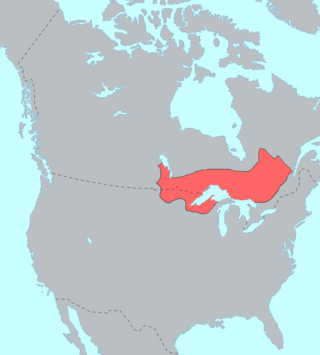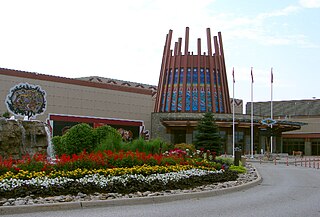Related Research Articles

John Graves Simcoe was a British Army general and the first lieutenant governor of Upper Canada from 1791 until 1796 in southern Ontario and the watersheds of Georgian Bay and Lake Superior. He founded York, which is now known as Toronto, and was instrumental in introducing institutions such as courts of law, trial by jury, English common law, freehold land tenure, and also in the abolition of slavery in Upper Canada.

The Ojibwe are an Anishinaabe people whose homeland covers much of the Great Lakes region and the northern plains, extending into the subarctic and throughout the northeastern woodlands. Ojibweg, being Indigenous peoples of the Northeastern Woodlands and of the subarctic, are known by several names, including Ojibway or Chippewa. As a large ethnic group, several distinct nations also understand themselves to be Ojibwe as well, including the Saulteaux, Nipissings, and Oji-Cree.

James FitzGibbon was a public servant, prominent freemason of the masonic lodge from 1822 to 1826, member of the Family Compact, and an Irish soldier in the British Army in Europe before and in the Canadas during the War of 1812 who received messages of warning from two Canadian folk heroes: Laura Secord (Ingersoll) and Billy Green.

John Strachan was a notable figure in Upper Canada, an "elite member" of the Family Compact, and the first Anglican Bishop of Toronto. He is best known as a political bishop who held many government positions and promoted education from common schools to helping to found the University of Toronto.
The Council of Assiniboia was the first appointed administrative body of the District of Assiniboia, operating from 1821 until 1870. It was this council who is credited for the arrival of a functioning legal system, a local police force, and a militia to the vast wilderness that was the fur-trading territory of Rupert's Land. Over its existence, the Council of Assiniboia transformed numerous times in an effort to bring law and order to a young colonial settlement that was rife with tension and hardship.
Peter Robinson was a Canadian politician who served as Commissioner of Crown Lands as well as on the Legislative Assembly, Legislative Council, and Executive Council of Upper Canada. He is known for his work in organizing the migration and settlement of what is now Peterborough, Ontario.

James Macaulay M.D., J.P. was the Chief Medical Officer of Upper Canada; a landowner and Justice of the Peace for York, Upper Canada.

William Benjamin Robinson was a fur trader and political figure in Upper Canada.

Lhatŝ’aŝʔin, was a chief of the Chilcotin (Tsilhqot'in) people. He led a small group of warriors in attacks on road-building crews near Bute Inlet, British Columbia, in April and May 1864. The road crews had been starving and underpaying Tsilhqot'in workers, which provoked Lhatŝ’aŝʔin to declare war. On 29 April 1864, Lhatŝ’aŝʔin arrived at a ferry site 30 mi (48 km) up the Homathko River. He and his warriors killed ferry-keeper Tim Smith, plundering the food and stores kept there.

Edward Bowen was an Irish-born lawyer, judge and political figure in Lower Canada. He was the first Chief Justice of the Superior Court for provincial Quebec, the second Chancellor of Bishop's University, in Sherbrooke, and the first King's Counsel in Lower Canada in 1809.

Chippewas of Rama First Nation, also known as Chippewas of Mnjikaning and Chippewas of Rama Mnjikaning First Nation, is an Anishinaabe (Ojibway) First Nation located in the province of Ontario in Canada. The name Mnjikaning, or fully vocalized as Minjikaning, refers to the fishing weirs at Atherley Narrows between Lake Simcoe and Lake Couchiching and it means "in/on/at or near the fence".

Ozaawindib (Ojibwe) was an early 19th century agokwa warrior. Ozaawindib, who was born male, at times wore attire more typically associated with women. Ozaawindib had several husbands and was considered in a number of ways to be gender-nonconforming.

Augustus Jones was a North American-born Upper Canadian farmer, land speculator, magistrate, militia captain and surveyor. Jones trained as a surveyor in New York City, and fled as a United Empire Loyalist to Upper Canada. In Upper Canada, he worked as a crown surveyor in the Nassau District, where he quickly rose to the position of Deputy Surveyor General, the highest position in a district of Upper Canada. He occupied that position from 1789 informally, and 1791 formally, until his retirement in 1799. During that time he laid down many of the township boundaries in the Niagara Peninsula and on the north shore of Lake Ontario. He led various teams that cut many of the first sideroads and concession roads into these areas, facilitating their settlement by European and American immigrants. Jones also surveyed the routes for Dundas Street and Yonge Street, and supervised their construction. After his retirement, Jones farmed first in Saltfleet Township, later moving to Brantford and finally an estate outside Paris named Cold Springs, where he died in 1836.
Colonel James Givins was a British Army officer and militiaman who fought in the American Revolution and the War of 1812. He was also a senior officer in the Indian Department of Upper Canada, serving as Chief Superintendent from 1830 to 1837. He is the namesake of Givins Street in Toronto.

John Elmsley was Chief Justice of Upper Canada and afterwards of Lower Canada. In both of the Canadas he served as President of the Executive Council and Speaker of the Legislative Council. During the Hunter administration, he was the most powerful man in Upper Canada. In Lower Canada, from 1802 until his death he was second only in rank to the Lieutenant Governor.
Francis Assikinack was a 19th-century Ojibwe historian. Assikinack was born on Manitoulin Island. He was raised learning only Ojibwe and did not learn English until after enrolling at Upper Canada College in 1840. His father Jean-Baptiste Assiginack was a prominent leader of the Ojibwe.
Jean-Baptiste Assiginack was an Odawa leader in the early 19th-century. He was also known as "Blackbird," a literal translation of his name in the Anishinaabe language.
William Yellowhead, or "Musquakie" or "Misquuckkey", as he was known in Ojibwe was the "head chief" of the Chippaweans of Lakes Huron and Simcoe and leader of the Deer clan of that people from 1817 until his death in 1864. He led his people in taking arms in defence of Upper Canada in the Upper Canada Rebellion, oversaw the sale of the bulk of their territory to the provincial government, and led them in their first attempts to adopt an agrarian way of life. Although the claims of several other persons have been advanced, it is generally believed that Musquakie is the origin of the name of the District Municipality of Muskoka.
John Aisance was a chief among the Chippewas of Lakes Huron and Simcoe and leader of the Otter clan of that people from at least 1815 until his death in 1847. He participated in the Lake Simcoe–Lake Huron Purchase in 1815, served the provincial government during the Upper Canada Rebellion, and was the first and founding chief of the Beausoleil First Nation.
Joseph Snake was an Ojibwe chief belonging to the Chippewas of Lakes Huron and Simcoe from sometime before 1842 until his death in 1861.
References
- ↑ Murray (ed.), Muskoka and Haliburton, 100-101
- ↑ "Biography – MUSQUAKIE – Volume IX (1861-1870) – Dictionary of Canadian Biography".
- ↑ "Biography – MUSQUAKIE – Volume IX (1861-1870) – Dictionary of Canadian Biography".